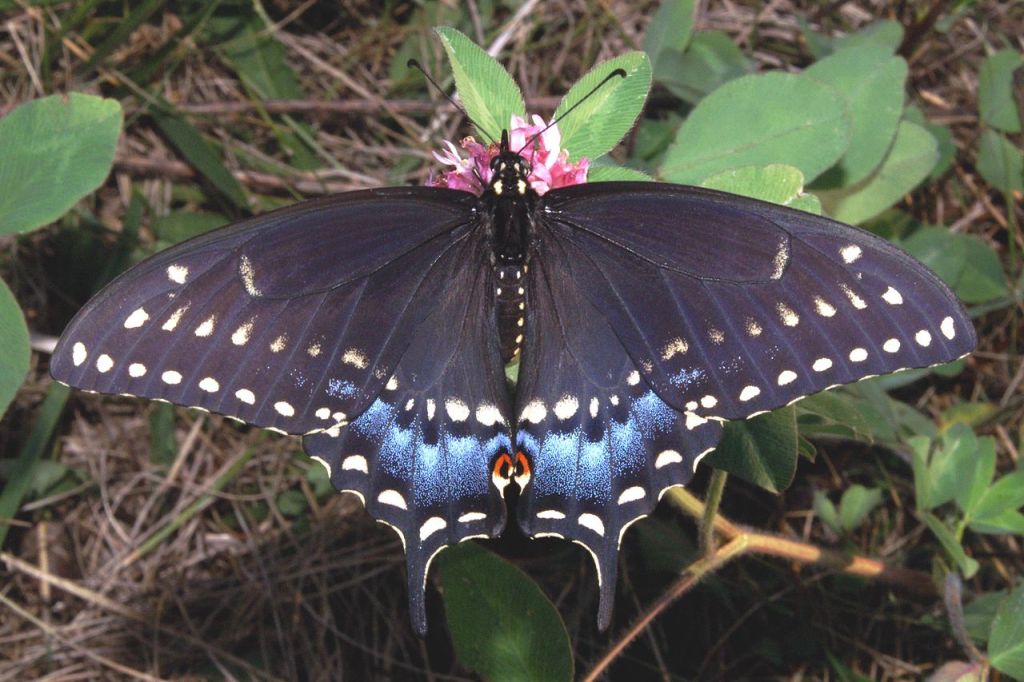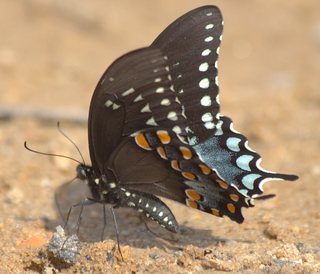Swallowtails, so beautiful, so fast. They begin to speed through our yard in late May or early June, and continue showing up now and then throughout the summer. In southern Iowa there are 6 species of swallowtail butterflies that we can see:
- the eastern tiger swallowtail (Papilio glaucus)
- black swallowtail (Papilio polyxene)
- giant swallowtail (Papilio cresphontes)
- spicebush swallowtail (Papilio troilus)
- pipevine swallowtail (Battus philenor)
- and the zebra swallowtail (Protographium marcellus)
The first three are found throughout the eastern U.S., and the last three don’t go much further north than Iowa -the last two, zebra, and pipevine swallowtails are considered visitors, and not truly resident butterflies (so it’s extra special if you see one!). If any of these awesome swallowtails visits your yard, and they slow down enough for you to get a look at them, hopefully the following photo gallery can help you easily ID your swallowtail. And if you know which swallowtails are in your area, then you know which host plants to plant for next year (hooray!). Interestingly (and perhaps inconveniently), each species has a different host plant for their caterpillars! What?! Let’s break it down!
Swallowtail Identification
Eastern tiger swallowtails
Black swallowtails
Giant swallowtails

Giant swallowtail, Photo by D. Gordon E. Robinson CC
Pipevine Swallowtails
Spicebush swallowtails
Zebra swallowtails
The North American Mimicry Complex
Now, if you were looking at some of the species up above and thinking, “What! These look the same!” you would be right. What we have here in our swallowtails is a case of mimicry. Among various species, what we see is that often, if there is a truly disgusting butterfly (to the taste of toads, birds, and other predators, of course), through natural selection and millions of years, numerous other butterflies end up looking like the gross butterfly (the scientific term is “unpalatable”). In a sense, the disgusting butterfly, by virtue of being so disgusting, creates a predator-free space, and we see that simply looking like the disgusting or toxic butterfly, allows a delicious butterfly to enter that predator-free space -no one even wants to risk eating them. In the case of swallowtails, a dark butterfly with blue on the bottom wings -forget about it! No way does anyone want to eat that nasty butterfly. They gain longer lives, increased reproduction, and over evolutionary time, mimicry develops. Mimicking an unpalatable or toxic “model” is called Batesian mimicry.
“Perhaps, the peak of Batesian mimetic perfection, diversity, and complexity is seen in butterflies…”
Krushnamegh Kunte from THE DIVERSITY AND EVOLUTION OF BATESIAN MIMICRY IN PAPILIO SWALLOWTAIL BUTTERFLIES
And we see that about 25% of the approximately 200 species of swallowtail butterflies are mimics. In fact, half of our local swallowtails have ended up mimics. Me personally (if it were up to me!), I would have them all look different, but it’s not up to me, it’s up to natural selection.

According to Sylvio G. Codella, entomologist and evolutionary ecologist at Kean University, what we have here is an “extensive North American mimicry complex,” consisting of the eastern tiger swallowtail, the black swallowtail, the pipevine swallowtail, the spicebush swallowtail, red-spotted purples, and female dianas. So just who is the nasty butterfly?? It is the beautiful-nasty pipevine swallowtail.
And once again the swallowtail mimics

Spicebush swallowtail, Photo by Greg Hume CC 
Female black swallowtail, Photo by Kenneth Harrelson CC 
Female eastern tiger swallowtail black morph, by Shanandoah National Park CC
Why Pipevine Swallowtails Are Repulsive
Pipevine Swallowtail caterpillars feed exclusively on plants in the genus Aristolochia (a group of plants known as Dutchman’s pipes). The caterpillars store aristolochic acids from the plants, and render themselves, their pupae form, their adult form, and their future eggs distasteful and toxic.

Dutchman’s pipevine, Aristolochia macrophylla, Photo by Orchi CC
Aristolochia macrophylla, is probably the most widespread Dutchman’s pipe vine, and the one most commonly sold, but according to an article by the North American Butterfly Association, woolly Dutchman’s pipe vine, Aristolochia tomentosa, might be a better suited choice for Midwest gardens.
Attracting Swallowtails
When encouraging butterflies to visit your yard, the best strategy is to plant both host plants for the caterpillars and preferred nectar plants for the adults. Host plants will get a swallowtail’s attention, and if they can find some nectar plants, too, they might just decide to stay for awhile.
Midwestern host and nectar plants for swallowtails
| Species | Host Plants | Nectar Plants |
|---|---|---|
| Eastern tiger swallowtail | Wild black cherry, Prunus serotina Sweet bay magnolia, Magnolia virginiana Tulip trees, Liriodendron tulipifera | Crabapple, Malus spp. Joe Pye weed, Eutrochium spp. Wild plum, Prunus americana Garden phlox, Phlox paniculata Buttonbush, Cephalanthus occidentalis |
| Black swallowtail | Curly-leaved parsley (very attractive by some reports) Dill Fennel Golden alexanders, Zizia spp. | Milkweeds, Asclepias spp. Joe Pye weed, Eutrochium spp. Blazingstars, Liatris spp. |
| Giant swallowtail | Prickly Ash, Zanthoxylum americanum Common Hoptree, Ptelia trifoliata | Swamp Milkweed, Asclepias incarnata Beebalm, Monarda fistulosa Ironweeds, Vernonia spp. Thistles, Circium spp. |
| Spicebush swallowtail | Spicebush, Lindera benzoin White sassafras, Sassafras albidum | Milkweeds, Asclepias spp. Joe-Pye weed, Eutrochium spp. Bazingstars, Liatris spp. Thistles, Circium spp. Jewel weed, Impatiens capensis |
| Pipevine swallowtail | Dutchman’s pipe vine, Aristolochia spp. Woolly Dutchman’s pipe for the midwest, Aristolochia tomentosa | Phlox, Phlox spp. Ironweeds, Vernonia spp. Thistles, Circium spp. |
| Zebra swallowtail | Common pawpaw, Asmina triloba | Blackberry, Rubus spp. Blueberries, Vaccinium spp. Dogbane, Apocynum cannibinum Butterflyweed, Asclepias tuberosa |
What types of swallowtails have you seen in your yard? Let me know!
Resources:
THE DIVERSITY AND EVOLUTION OF BATESIAN MIMICRY IN PAPILIO SWALLOWTAIL BUTTERFLIES. Kunte, K. (2009). Evolution, 63: 2707-2716.
Featured creatures, Pipevine Swallowtail, by Donald W. Hall http://entnemdept.ufl.edu/creatures/bfly/pipevine_swallowtail.htm
A tale of four swallowtails, Ansel Oommen, Front Ecol Environ 2018; 16( 6): 335– 335
The Gardener’s Butterfly Book, Alan Branhagen
Butterfly mimicry through the eyes of bird predators, by Tata Institute of Fundamental Research
Host Plant: Aristolochia, by Lenora Larson, North America Butterfly Association
From a Caterpillar to a Butterfly; Don’t Eat ’em -Here’s Why, by Kathy Keatley Garvey
How a “flipped” gene helped butterflies evolve mimicry, by Matt Wood
Signal categorization by foraging animals depends on ecological diversity, Kikuchi et al. eLife 2019; 8:e43965.
Intersexual Comparison of Mimetic Protection in the Black Swallowtail Butterfly, Papilio polyxenes: Experiments with Captive Blue Jay Predators. Codella, S., & Lederhouse, R. (1989). Evolution,43 (2), 410-420.













4 replies on “Mimicry and the Swallowtails”
I think we’ve seen a spicebush swallowtail in the Adirondacks…sometimes a butterfly floats quickly through our backyard in Brooklyn, but by the time i get downstairs it’s gone. So far, we’re much better at attracting snails, slugs and pill bugs!
LikeLike
Ha!
LikeLike
[…] Female Eastern Tiger Swallowtail blue morph, part of the infamous “North American Mimicry Complex,” visiting Joe Pye weed. Swallowtails seem to love Joe Pye […]
LikeLike
[…] female tiger swallowtail on beautiful […]
LikeLike